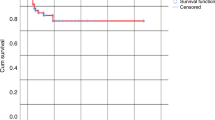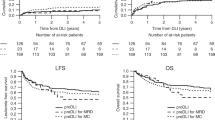Abstract
Juvenile myelomonocytic leukemia (JMML) is a clonal myeloproliferative disorder of early childhood. In all, 21 patients with JMML who received donor leukocyte infusion (DLI) after allogeneic hematopoietic stem cell transplantation (HSCT) for either mixed chimerism (MC, n=7) or relapse (n=14) were studied. Six patients had been transplanted from an HLA-matched sibling and 15 from other donors. Six of the 21 patients (MC: 3/7 patients; relapse: 3/14 patients) responded to DLI. Response rate was significantly higher in patients receiving a higher total T-cell dose (⩾1 × 107/kg) and in patients with an abnormal karyotype. None of the six patients receiving DLI from a matched sibling responded. Response was observed in five of six patients who did and in one of 15 children who did not develop acute graft-versus-host disease following DLI (P=0.01). The overall outcome was poor even for the responders. Only one of the responders is alive in remission, two relapsed, and three died of complications. In conclusion, this study shows that some cases of JMML may be sensitive to DLI, this providing evidence for a graft-versus-leukemia effect in JMML. Infusion of a high number of T cells, strategies to reduce toxicity, and cytoreduction prior to DLI may improve the results.
This is a preview of subscription content, access via your institution
Access options
Subscribe to this journal
Receive 12 print issues and online access
$259.00 per year
only $21.58 per issue
Buy this article
- Purchase on Springer Link
- Instant access to full article PDF
Prices may be subject to local taxes which are calculated during checkout
Similar content being viewed by others
References
Niemeyer CM, Aricò M, Basso G, Biondi A, Cantù-Rajnoldi A, Creutzig U et al. Chronic myelomonocytic leukemia in childhood: a report of 110 cases. Blood 1997; 89: 3534–3543.
Hasle H, Niemeyer CM, Chessells JM, Baumann I, Bennett JM, Kerndrup G et al. A pediatric approach to the WHO classification of myelodysplastic and myeloproliferative diseases. Leukemia 2003; 17: 277–282.
Hasle H, Niemeyer C . Myelodysplastic syndrome and juvenile myelomonocytic leukemia in children. In: Bennett JM (ed), The Myelodysplastic Syndromes. New York, Basel: Marcel Dekker, Inc., 2002, pp 299–344.
Flotho C, Valcamonica S, Mach-Pascula S, Schmahl G, Corral L, Ritterbach J et al. Ras mutations and clonality analysis in children with juvenile myelomonocytic leukemia (JMML). Leukemia 1999; 13: 32–37.
Side LE, Emanuel PD, Taylor B, Franklin J, Thompson P, Castleberry RP et al. Mutations of the NF1 gene in children with juvenile myelomonocytic leukemia without clinical evidence of neurofibromatosis, type 1. Blood 1998; 92: 267–272.
Tartaglia M, Niemeyer CM, Song X, Buechner J, Hählen K, Hasle H et al. Somatic PTPN11 mutations in juvenile myelomonocytic leukemia, myelodysplastic syndromes and acute myeloid leukemia. Nat Genet 2003; 34: 148–150.
Locatelli F, Nöllke P, Zecca M, Korthof E, Lanino E, Peters C, Pession A, Kabisch H, Uderzo et al. Hematopoietic stem cell transplantation (HSCT) in children with juvenile myelomoncytic leukemia (JMML): results of the EWOG-MDS/EBMT trial. Blood 2005; 105: 410–419.
Manabe A, Okamura J, Yumura-Yagi K, Akiyama Y, Sako M, Uchiyama H et al. Allogeneic hematopoietic stem cell transplantation for 27 children with juvenile myelomonocytic leukemia diagnosed based on the criteria of the International JMML Working Group. Leukemia 2002; 16: 645–649.
Locatelli F, Niemeyer C, Angelucci E, Bender-Götze C, Burdach S, Ebell W et al. Allogenic bone marrow transplantation for chronic myelomonocytic leukemia in childhood: a report from the European Working Group on Myelodysplastic Syndrome in Childhood. J Clin Oncol 1997; 15: 566–573.
Smith FO, King R, Nelson G, Wagner JE, Robertson KA, Sanders JE et al. Unrelated donor bone marrow transplantation for children with juvenile myelomonocytic leukaemia. Br J Haematol 2002; 116: 716–724.
Matthes-Martin S, Mann G, Peters C, Lion T, Fritsch G, Haas OA et al. Allogeneic bone marrow transplantation for juvenile myelomonocytic leukaemia: a single centre experience and review of the literature. Bone Marrow Transplant 2000; 26: 377–382.
Worth A, Rao K, Webb D, Chessells J, Passmore J, Veys P . Successful treatment of juvenile myelomonocytic leukemia relapsing post stem cell transplant using donor lymphocyte infusion. Blood 2003; 101: 1713–1714.
Pulsipher MA, Adams RH, Asch J, Petersen FB . Successful treatment of JMML relapsed after unrelated allogeneic transplant with cytoreduction followed by DLI and interferon-alpha: evidence for a graft-versus-leukemia effect in non-monosomy-7 JMML. Bone Marrow Transplant 2004; 33: 113–115.
Neudorf S, Nourani A, Kempert P, Shen V, Sender L, Kirov I . Chemotherapy and donor leukocyte infusions for relapsed juvenile myelomonocytic leukemia (JMML). Bone Marrow Transplant 2004; 33: 1069.
Bader P, Holle W, Klingebiel T, Handgretinger R, Niethammer D, Beck J . Quantitative assessment of mixed hematopoietic chimerism by polymerase chain reaction after allogeneic BMT. Anticancer Res 1996; 16: 1759–1763.
Lion T, Muller-Berat N . Chimerism testing after allogeneic stem cell transplantation: importance of timing and optimal technique for chimerism testing in different clinical-biological situations. Leukemia 1999; 13: 2059.
Thiede C, Florek M, Bornhauser M, Ritter M, Mohr B, Brendel C et al. Rapid quantification of mixed chimerism using multiplex amplification of short tandem repeat markers and fluorescence detection. Bone Marrow Transplant 1999; 23: 1055–1060.
Allen RC, Graves G, Budowle B . Polymerase chain-reaction amplification products separated on rehydratable polyacrylamide gels and stained with silver. Biotechniques 1989; 7: 736–744.
Formankova R, Honzatkova L, Moravcova J, Sieglova Z, Dvorakova R, Nadvornikova S et al. Prediction and reversion of post-transplant relapse in patients with chronic myeloid leukemia using mixed chimerism and residual disease detection and adoptive immunotherapy. Leukemia Res 2000; 24: 339–347.
de Weger RA, Tilanus MGJ, Scheidel KC, van den Tweel JG, Verdonck LF . Monitoring of residual disease and guided donor leucocyte infusion after allogeneic bone marrow transplantation by chimaerism analysis with short tandem repeats. Br J Haematol 2000; 110: 647–653.
Glucksberg H, Storb R, Fefer A, Buckner CD, Neiman PE, Clift RA et al. Clinical manifestations of graft-versus-host disease in human recipients of marrow from HL-A-matched sibling donors. Transplantation 1974; 18: 295–304.
Shulman HM, Sullivan KM, Weiden PL, McDonald GB, Striker GE, Sale GE et al. Chronic graft-versus-host syndrome in man. A long-term clinicopathologic study of 20 Seattle patients. Am J Med 1980; 69: 204–217.
Fisher RA . Statistical Methods and Scientific Inference. Edinburgh: Oliver and Boyd ed., 1956.
Mann HB, Whitney DR . On a test of whether one or two random variables ist stochastically larger than the other. Ann Math Stat 1947; 18: 50–60.
Rassam SM, Katz F, Chessells JM, Morgan G . Successful allogeneic bone marrow transplantation in juvenile CML: conditioning or graft-versus-leukaemia effect? Bone Marrow Transplant 1993; 11: 247–250.
Kressler EJ, Haas OA, Konig M, Mann G, Mayer H, Peters C et al. Extramedullary relapse despite graft-versus-leukemia effect after bone marrow transplantation in a girl with juvenile myelomonocytic leukemia. Leukemia Lymphoma 1999; 33: 597–600.
Orchard PJ, Miller JS, McGlennen R, Davies SM, Ramsay NK . Graft-versus-leukemia is sufficient to induce remission in juvenile myelomonocytic leukemia. Bone Marrow Transplant 1998; 22: 201–203.
MacMillan ML, Davies SM, Orchard PJ, Ramsay NK, Wagner JE . Haemopoietic cell transplantation in children with juvenile myelomonocytic leukaemia. Br J Haematol 1998; 103: 552–558.
Ohta H, Kawai M, Sawada A, Tokimasa S, Fujisaki H, Matsuda Y et al. Juvenile myelomonocytic leukemia relapsing after allogeneic bone marrow transplantation successfully treated with interferon-alpha. Bone Marrow Transplant 2000; 26: 681–683.
Lutz P, Zix-Kieffer I, Souillet G, Bertrand Y, Dhooge Y, Rubie H et al. Juvenile myelomonocytic leukemia: analyses of treatment results in the EORTC childrens leukemia cooperative group (CLCG). Bone Marrow Transplant 1996; 18: 1111–1116.
Passmore SJ, Chessells JM, Kempski H, Hann IM, Brownbill PA, Stiller CA . Paediatric myelodysplastic syndromes and juvenile myelomonocytic leukaemia in the UK: a population-based study of incidence and survival. Br J Haematol 2003; 121: 758–767.
Collins Jr RH, Shpilberg O, Drobyski WR, Porter DL, Giralt S, Champlin R et al. Donor leukocyte infusions in 140 patients with relapsed malignancy after allogeneic bone marrow transplantation. J Clin Oncol 1997; 15: 433–444.
Kolb HJ, Schattenberg A, Goldman JM, Hertenstein B, Jacobsen N, Arcese W et al. Graft-versus-leukemia effect of donor lymphocyte transfusions in marrow grafted patients. European Group for Blood and Marrow Transplantation Working Party Chronic Leukemia. Blood 1995; 86: 2041–2050.
van Rhee F, Savage D, Blackwell J, Orchard K, Dazzi F, Lin F et al. Adoptive immunotherapy for relapse of chronic myeloid leukemia after allogeneic bone marrow transplant: equal efficacy of lymphocytes from sibling and matched unrelated donors. Bone Marrow Transplant 1998; 21: 1055–1061.
Dazzi F, Szydlo RM, Cross NC, Craddock C, Kaeda J, Kanfer E et al. Durability of responses following donor lymphocyte infusions for patients who relapse after allogeneic stem cell transplantation for chronic myeloid leukemia. Blood 2000; 96: 2712–2716.
Slavin S, Naparstek E, Nagler A, Ackerstein A, Samuel S, Kapelushnik J et al. Allogeneic cell therapy with donor peripheral blood cells and recombinant human interleukin-2 to treat leukemia relapse after allogeneic bone marrow transplantation. Blood 1996; 87: 2195–2204.
Nadal E, Fowler A, Kanfer E, Apperley J, Goldman J, Dazzi F . Adjuvant interleukin-2 therapy for patients refractory to donor lymphocyte infusions. Experimental Hematology 2004; 32: 218–223.
van Rhee F, Lin F, Cullis JO, Spencer A, Cross NC, Chase A et al. Relapse of chronic myeloid leukemia after allogeneic bone marrow transplant: the case for giving donor leukocyte transfusions before the onset of hematologic relapse. Blood 1994; 83: 3377–3383.
Bader P, Beck J, Frey A, Schlegel PG, Hebarth H, Handgretinger R et al. Serial and quantitative analysis of mixed hematopoietic chimerism by PCR in patients with acute leukemias allows the prediction of relapse after allogeneic BMT. Bone Marrow Transplant 1998; 21: 487–495.
Bader P, Kreyenberg H, Hoelle W, Dueckers G, Handgretinger R, Lang P et al. Increasing mixed chimerism is an important prognostic factor for unfavorable outcome in children with acute lymphoblastic leukemia after allogeneic stem-cell transplantation: Possible role for pre-emptive immunotherapy? J Clin Oncol 2004; 22: 1696–1705.
Bernard F, Thomas C, Emile JF, Hercus T, Cassinat B, Chomienne C et al. Transient hematologic and clinical effect of E21R in a child with end-stage juvenile myelomonocytic leukemia. Blood 2002; 99: 2615–2616.
Acknowledgements
We thank the affected individuals and their families who participated in this study, the physicians who referred the patients, Dr I Baumann and Dr G Kerndrup for reference morphology review, Dr O Haas, Dr J Harbott, Dr K Michalova and Dr B Beverloo for reference review of cytogenetic studies. This work was supported by the Deutsche José Carreras Leukämie-Stiftung e.V., München, Germany, the Deutsche Krebshilfe, Bonn, Germany, and the Alexander von Humboldt-Stiftung, Bonn, Germany.
Author information
Authors and Affiliations
Consortia
Corresponding author
Rights and permissions
About this article
Cite this article
Yoshimi, A., Bader, P., Matthes-Martin, S. et al. Donor leukocyte infusion after hematopoietic stem cell transplantation in patients with juvenile myelomonocytic leukemia. Leukemia 19, 971–977 (2005). https://doi.org/10.1038/sj.leu.2403721
Received:
Accepted:
Published:
Issue Date:
DOI: https://doi.org/10.1038/sj.leu.2403721
Keywords
This article is cited by
-
Second allogeneic stem cell transplantation can rescue a significant proportion of patients with JMML relapsing after first allograft
Bone Marrow Transplantation (2023)
-
Anti-proliferative effects of T cells expressing a ligand-based chimeric antigen receptor against CD116 on CD34+ cells of juvenile myelomonocytic leukemia
Journal of Hematology & Oncology (2016)
-
Transplantation for juvenile myelomonocytic leukemia: a retrospective study of 30 children treated with a regimen of busulfan, fludarabine, and melphalan
International Journal of Hematology (2015)
-
T Cell Immunotherapy for Immune Reconstitution and GVHD Prevention After Allogeneic Hematopoietic Stem Cell Transplantation
Current Stem Cell Reports (2015)
-
Risk-adapted donor lymphocyte infusion based on chimerism and donor source in pediatric leukemia
Blood Cancer Journal (2013)



